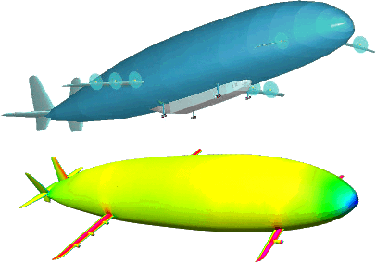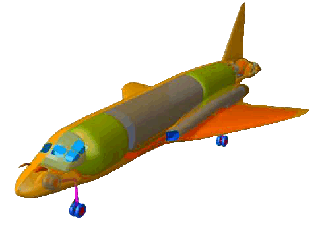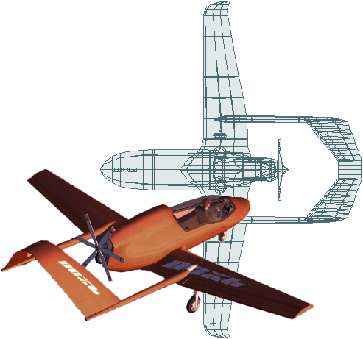![[Conceptual Research Corp.]](titletextcrc.gif)
![[Conceptual Research Corp.]](titletextcrc.gif)
| Below is a sampling of Conceptual Research Corporation projects. Click here or on the button to return to the main CRC page. For further information contact Conceptual Research Corporation |

 CRC assisted Composite Engineering Inc in the design of the
BQM-167 "Skeeter", the new USAF transonic jet-powered target drone UAV. CRC helped with the conceptual
design, participated in wind tunnel and water tunnel testing, and performed an on-site design review.
CRC also supported a review of launch procedures aimed at maximizing launch reliability and safety.
CRC assisted Composite Engineering Inc in the design of the
BQM-167 "Skeeter", the new USAF transonic jet-powered target drone UAV. CRC helped with the conceptual
design, participated in wind tunnel and water tunnel testing, and performed an on-site design review.
CRC also supported a review of launch procedures aimed at maximizing launch reliability and safety.
The BQM-167 is now in high-rate production and operating at Eglin AFB. Built of carbon fiber composites, it flies at over M0.9 and reaches 50,000 feet with 3 hours of flight endurance. It can be air or ground launched, and can carry a range of target payloads including radar enhancers, IR sources, countermeasures, scoring devices, and towed targets. Other applications are being studied.
Its only problem, apparently,
is that it is so slick and maneuverable that it is hard for opposing pilots to
shoot it down. This is, after all, the purpose of a target drone! One vehicle in particular,
Tail Number 04-0113, survived 40 attacks from AIM-9, AIM-9X, and AIM-120 missiles. The crew named
it "Rasputin" after the
mad Russian monk and advisor to the Czar, who survived repeated assassination attempts. Tragically, Rasputin, like his
namesake, finally succumbed to a cowardly assassination. On February 19, 2009 it was deliberately killed in flight to "retire" it from
the fleet, making way for a younger airframe.
![[rocket]](reusable_rocket_concept.gif) For the last five years, CRC has been heavily involved in the ongoing USAF reusable launch vehicle project at AFRL-VA (WPAFB). Variously
called Micro-X, Hot Eagle, and now FAST (Future Responsive Access to Space Technology), this project seeks to develop
and mature technologies that will allow development of future military launch vehicles that can land to launch
another day. Current efforts are focused upon ground demonstration of technologies but the future may see a
flight demonstrator.
For the last five years, CRC has been heavily involved in the ongoing USAF reusable launch vehicle project at AFRL-VA (WPAFB). Variously
called Micro-X, Hot Eagle, and now FAST (Future Responsive Access to Space Technology), this project seeks to develop
and mature technologies that will allow development of future military launch vehicles that can land to launch
another day. Current efforts are focused upon ground demonstration of technologies but the future may see a
flight demonstrator.
CRC has had the lead designer role in the project, developing the government baseline design and numerous trade study configurations (the design to the left is an early version). CRC has led a broad subcontract team to address relevant issues, including such companies as Convergence Engineering Corp., Composite Technology Development Inc., Universal Space Lines LLC, Analytic Methods Inc., Composite Engineering Inc, CAEDSS Inc., and Andrews Space Inc.
CRC also did the preliminary performance analysis using its own "ROAST" trajectory code, which is a 3-DOF simulation based upon and using the RDS-Professional data structure. This allows rapid simulation of boost, coast, reentry, and landing. ROAST results were compared to the industry-standard POST code and found to be in good agreement.
Base upon Dr. Raymer's latest design concept baseline, the USAF awarded major technology hardware demonstration contracts to Northrop-Grumman, Lockheed Martin, and Honeywell. Results will provide a significant expansion in the reusable launch vehicle technology base and will offer significant risk reduction for an eventual flight test program.
An overview paper about this project can be
found here.
Ohio Airship "Dynalifter"

 For Ohio Airship Inc., CRC performed the initial design and analysis of the
"Dynalifter", a hybrid flight vehicle combining hydrostatic lift from helium with aerodynamic lift from wings and a shaped hull.
This concept avoids many of the problems of traditional airships since a large fraction of its weight is carried by
aerodynamic lift. It lands like a normal aircraft, decelerating on a runway as its weight is transferred from the wings to the tires. It has substantial weight
on its tires when sitting on the ground allowing it to withstand a gusty side wind. Compared to a normal aircraft, the dynamic lift airship has reduced
drag when flown at low speeds and flies on much less power than a conventional aircraft carrying a similar payload.
For Ohio Airship Inc., CRC performed the initial design and analysis of the
"Dynalifter", a hybrid flight vehicle combining hydrostatic lift from helium with aerodynamic lift from wings and a shaped hull.
This concept avoids many of the problems of traditional airships since a large fraction of its weight is carried by
aerodynamic lift. It lands like a normal aircraft, decelerating on a runway as its weight is transferred from the wings to the tires. It has substantial weight
on its tires when sitting on the ground allowing it to withstand a gusty side wind. Compared to a normal aircraft, the dynamic lift airship has reduced
drag when flown at low speeds and flies on much less power than a conventional aircraft carrying a similar payload.
Tourism and long-endurance surveillance would be ideal applications for such a design due to the ability to fly slowly and safely using little power compared to an airplane, but at high speed compared to a traditional airship. A Dynalifter should also offer tremendous cargo-carrying ability especially for low-density payloads.
For initial sizing CRC developed a hybrid airship parametric computer analysis model and used it to perform
numerous trade studies to determine the ideal ratio of gas to aerodynamic lift. Then, CRC prepared and analyzed a number of configurations, ranging from
a million-pound cargo lifter with a payload of 350,000 lbs to a single-seat "baby" - it is only 120 feet long!
CRC's Dynalifter design was described in the cover article of the October 2006 issue of
Popular Mechanics.

Navy/USMC Multirole Strike Fighter
Another interesting CRC project was during the early days of the JSF (F-35) program. CRC did a multi-phase
study for the Center for Naval Analysis
of potential options for the next Navy/USMC strike fighter. CRC developed
notional designs of several alternative approaches for an advanced strike fighter including use of
STOVL for carrier operation as well as the traditional catapult and arresting gear. Numerous parametric
trade studies were performed to assess the weight, cost, and performance of various options and approaches.
Results were briefed to Flag-officer levels and several AIAA papers
(Raymer-IPLC 2000) were presented.
 CRC completed a two-phase conceptual design study for Pioneer Rocketplane (now Rocketplane Kistler). CRC designed
and analyzed a manned aircraft equipped with both air-breathing turbofans and a LOX/jet-fuel rocket motor. This uses the
in-flight transfer of jet fuel and LOX to permit single stage to space operation. While at the top of a ballistic arc, the
aircraft opens a payload bay door and ejects an upper stage which takes the payload the rest of the way to orbit.
CRC completed a two-phase conceptual design study for Pioneer Rocketplane (now Rocketplane Kistler). CRC designed
and analyzed a manned aircraft equipped with both air-breathing turbofans and a LOX/jet-fuel rocket motor. This uses the
in-flight transfer of jet fuel and LOX to permit single stage to space operation. While at the top of a ballistic arc, the
aircraft opens a payload bay door and ejects an upper stage which takes the payload the rest of the way to orbit.
CRC did all of the vehicle design work, and brought together a team of experience engineers to design and analyze the
subsystems and propulsion installation. CRC also did the air-breathing portion of the flight performance analysis and worked with
Rocketplane staff on the launch trajectory analysis.

Fuel Cell Electric Aircraft Design Study
In a NASA-Glenn study performed for WILCO International Associates, CRC developed an electric-powered hydrogen fuel cell
aircraft concept which would use a pusher configuration to allow the heavy propulsion system to be located near the
aircraft center of gravity. The tails are tailboom-mounted with an inverted V-tail arrangement. Design results indicated
that range and performance would be competitive with gasoline-powered aircraft, provided that estimates of the propulsion
system weight and power are attained.
(Solid model image courtesy Chuck Jodry, done using AutoDesk 3DS8 software, based on Raymer's design done in RDS-Professional)
Home | RDS | CRC | Books | Design Classes | Drawings | Links | Other Stuff | Raymer Bio